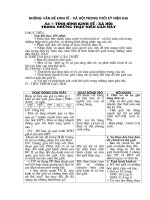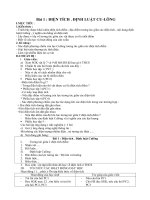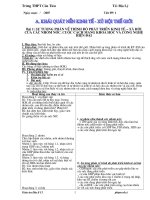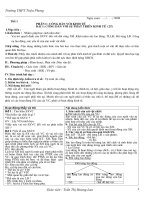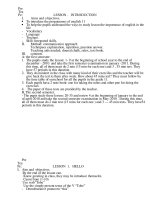Giáo án lớp 11 unit2 listening
Bạn đang xem bản rút gọn của tài liệu. Xem và tải ngay bản đầy đủ của tài liệu tại đây (179.67 KB, 6 trang )
SỞ GIÁO DỤC VÀ ĐÀO TẠO THANH HOÁ
TRƯỜNG THPT CHU VĂN AN
GIÁO ÁN KIẾN TẬP
Giáo viên hướng dẫn: Lưu Thị Tuyết
Giáo sinh kiến tập:
Hồ Thị Thơm
Lớp:
K24C- Sư Phạm Tiếng Anh
Ngành đào tạo:
Sư Phạm Tiếng Anh
Khoa:
Ngoại Ngữ
Năm học:
2023 - 2024
Thanh Hoá, năm 2023
Day of planning :
Day of teaching :
UNIT 2: THE GENERATION GAP
Period:
Lesson 5: Listening – Family conflicts
STAGE 1: DISIRED OBJECTIVES
I. OBJECTIVES
By the end of this lesson, Ss will be able to:
- Gain an overview about reasons for family conflicts;
- Memorize vocabulary to talk about family conflicts.
- Develop listening skills: listening for the main idea and listening for
specific details;
- Be collaborative and supportive in pair work and teamwork;
- Develop presentation skills;
- Be aware of family conflicts;
- Develop self-study skills;
- Actively join in class activities.
II. LANGUAGE FOCUS
Key terms/Vocabulary: disagreement (n), upset (adj), complain (about) (v),
allow (Sb to do Sth) (v), appearance (n)
Key grammatical structure(s):
III. MATERIALS
- Grade 11 textbook, Unit 2, Listening
- Computer connected to the Internet
- Projector / TV/ pictures and cards
- hoclieu.vn
STAGE 2: ASSESSMENT EVIDENCE
Performance tasks
1. Discuss and answer
the teachers’ questions
2. Guess the lexical
items and expression
related
to
family
conflicts and do task 1
3. Listen and do Task 2,
3
4. Discuss in groups the
question: Do you agree
with Mai’s mother and
Kevin’s parents? Why/
Why not? In Task 4
5.
Present
the
awareness about family
Performance products
Students’ answer
Assessment tools
Observation, questions
and answers
Students answers
Observation, questions
and answers
Students’ answers
Observation, answer
keys
Students’ conversations
Answer keys,
Observation
Students’ s talks
1
Observation, peer
correction,
conflicts
STAGE 3: LEARNING EXPERIENCE
LEAD IN
Activity 1:
WARM-UP : Watch a video:
Link: />- Teacher plays the video and asks the whole class to stand up.
- Ss watch the video and note down the reasons for family conflicts.
- Teacher calls some Ss to share, then confirms the answers.
- Teacher leads in the new lesson.
Activity 2: Pre- reading:
Vocabulary teaching:
Words
Pronunciation
Meaning
disagreement
/ˌdɪsə
A situation where
(n)
ˈɡriːmənt/
people have different
opinion about something
and often argue
upset (v)
/ˌʌpˈset/
to make somebody/
yourself feel unhappy,
anxious or annoyed
complain
/kəmˈpleɪn/
to say that you are
(about) (v)
annoyed, unhappy or not
satisfied about
somebody/something
allow (sb to do
/əˈlaʊ/
to let
st) (v)
somebody/something do
something; to let
something happen or be
done
appearance (n) /əˈpɪərəns/
the way that
somebody/something
looks on the outside;
what
somebody/something
seems to be
Vietnamese equivalent
sự bất đồng
gây khó chịu
phàn nàn (về)
cho phép (ai làm gì)
ngoại hình
- Teacher introduces the vocabulary.
- Teacher explains the meaning of the new vocabulary with different techniques
(pictures, actions, synonyms…)
- Teacher checks students’ understanding with the “Rub out and remember”
technique.
- Teacher asks Ss to take notes on their notebooks.
Task 1. Complete the following table about you. Work in pairs and
compare your answers.
- Teacher asks Ss to look at the picture and guess why the people are arguing.
2
- Teacher asks Ss to read the statements in the table and tick the correct
information about them.
- Teacher has Ss work in pairs to compare their answers. Encourage them to ask
each other questions and give more details about their answers.
- Teacher invites some Ss to share their answers or their partners’ answers with
the class.
Suggested answer:
The daughter is fed up with her mother telling her what to do all the time, and
refuses to listen.
Students’ own answers
Activity 3: WHILE LISTENING
Task 2: Listen to a conversation between Kevin and Mai. Number the
things they talk about in the order they are mentioned.
- Teacher explains the format of this activity: Ss listen and number the things the
speakers talk about in the order they are mentioned.
- Teacher has Ss read through statements carefully and check if they understand
the vocabulary and the context by asking questions such as Who are the
speakers? and What do you think they will be talking about?
- Teacher reminds Ss that the conversation may not contain the exact words as in
the statements so Ss should listen for synonyms or words with similar meaning,
e.g. screen time – the time I spend on my smartphone and laptop, disagreements
- conflict.
- Teacher plays the recording and has Ss listen and number the things listed in
the four statements.
- Teacher asks Ss to compare their answers in pairs or groups.
- Check answers by playing the recording again and pausing after the parts of
the conversation containing the information.
Answer key:
a-4
b-3
c-2
d–1
Task 3. Listen to the conversation again and answer the following questions
using no more than TWO words.
- Teacher has Ss read through the questions carefully and check if they
understand all the vocabulary.
3
- In stronger classes, ask Ss if they can answer the questions without listening to
the conversation again.
- In weaker classes, have Ss think about the type of information they will need to
answer each question, e.g. 1. something about Mai; 2. the place where Mai is
not allowed to wear tight jeans; 3. the main reason why Kevin uses his
smartphone and laptop; 4. the thing(s) Kevin’s parents worry about; 5. the time
when Kevin’s parents take his smartphone and laptop away.
- Teacher asks Ss to focus on the type of information that they will need.
Remind Ss of the word limit for each answer.
- Teacher plays the recording. Ask Ss to listen and take notes.
- Check answers as a class.
Extension: Play the recording, pausing before the last word of long sentences
and have Ss recall or guess it, e.g., play the sentence until the word
‘appearance’: She keeps complaining about my … Have Ss call out the last word.
In stronger classes, ask Ss to write the words on the board.
Answer key:
1. Mai’s appearance
2. At school.
3. (His) homework.
4. Kevin’s eyesight/ his eyesight.
5. 10 p.m.
Activity 4: POST-LISTENING
Task 4: Work in groups. Discuss the following questions.
- Teacher asks Ss to list the things that Mai’s and Kevin’s parents complain
about.
- Teacher puts Ss into groups. Ask each group to choose a question. Walk round
the class and offer help if necessary. Make sure Ss take notes of their discussion
and makes a short summary.
- Teacher invites Ss from some groups to share their opinions with the whole
class. Encourage them to give reasons.
- Ss answer the question : Do you agree with Mai’s mother and Kevin’s
parents? Why/Why not?
Activity 5. WRAP-UP & ASSIGNMENT
1. Wrap-up
- T asks Ss to talk about what they have learnt in the lesson.
2. Homework
- Do exercises in the workbook.
- Prepare for the next lesson –Writing.
GIÁO VIÊN HƯỚNG DẪN
GIÁO SINH
Lưu Thị Tuyết
Hồ Thị Thơm
4
5
